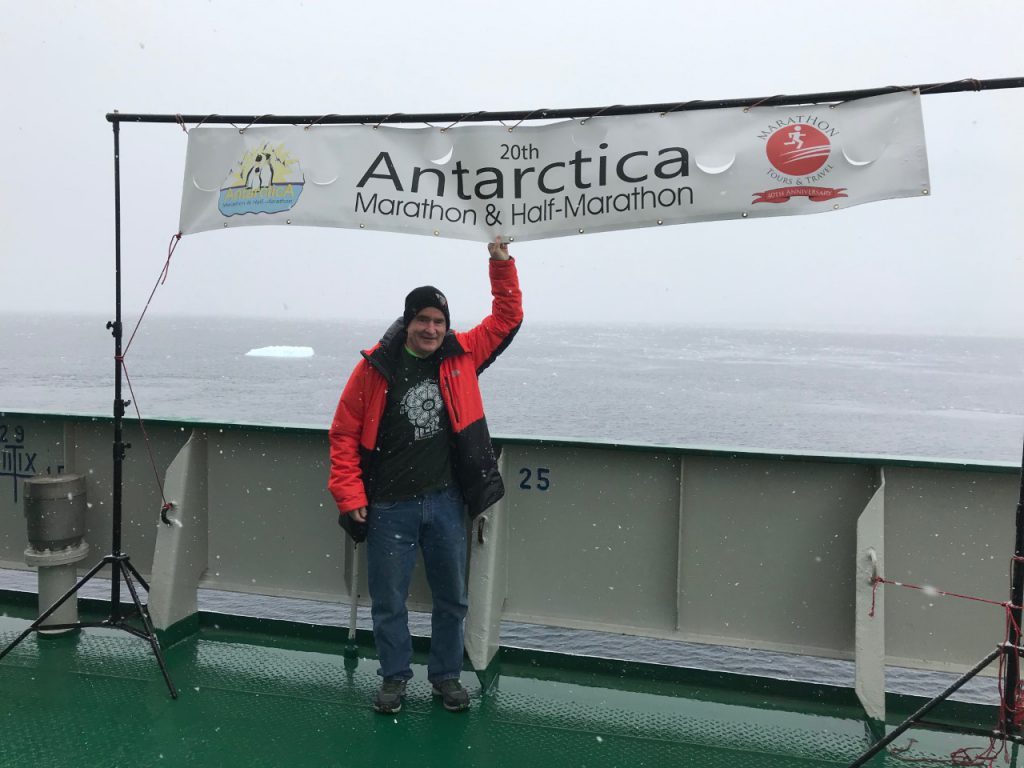
By Joey Kennedy
Michael Sloane and I have been diagnosed with Type 2 diabetes. I call it the fat guy diabetes.
But we each had different reactions to our diagnosis. I got depressed, then stopped drinking Cokes, switched to water, started walking more, and over several years lost about 100 pounds. Sloane, the director of the University Honors Program at UAB, was also discouraged by his diagnosis. Sloane, however, started running, not walking, and he fixed his diet.
Sloane and I, curiously, are the same age: 63 years old.
And while Sloane wasn’t as heavy as I was, he still lost 50 pounds and kept running. And running. And running.
Today, Sloane has run five marathons on five different continents. This month, he’ll run his sixth, in Africa (Carthage, Tunisia), and he hopes this summer to run his seventh, in South America (perhaps Chile, on Easter Island).
Seven marathons (26.2 miles) on seven continents. Yes, that includes Antarctica, an exclusive marathon he and 116 other runners completed last March. Sloane is in an elite club: As of this writing, only 527 men and 263 women across the world have completed that goal, according to Marathon Tours & Travel.
What makes Sloane’s quest even more remarkable is when Sloane started running in 2013, he didn’t really plan to become a marathoner. He just knew he had to exercise. He started at the UAB Rec Center, walking and running. His first organized run was the UAB Alumni Run in 2013. That is a 5K; Sloane isn’t claiming to be a world-class athlete.
“My goal for the first 5K was, first of all, finish,” he says. “My second was to finish without walking.” And Sloane wanted to complete the race in under 40 minutes. He accomplished all of those goals, finishing in 35:30, and he kept running. By early January 2014, Sloane ran a 10-mile race at 1:35:57. His first half-marathon was in February of 2014, the Mercedes Half-Marathon (2:10:58). Then, in October of 2014, Sloane joined more than 40,000 other runners in the Bank of America Chicago Marathon (5:22:51).
Sloane had run a marathon on his first continent (North America) in the city he calls his second home. Sloane completed his Ph.D. in psychology at Northwestern University, where he also met his wife, Cynthia Owsley, who is the Nathan E. Miles Chair of Ophthalmology and director of the clinical research unit at Callahan Eye Hospital at UAB. They keep an apartment in Chicago.
But Sloane, a native of Naas, Ireland, usually runs without his wife watching. “She barely knows when I’m running,” Sloane says, then chuckles.
While Sloane is in the cusp of a major world achievement, he didn’t start out planning to run a marathon on each of the seven continents. He just kept running.
“The goal is always to finish,” Sloane says. “And if I’m going to run seven, they might as well be on different continents.”
To run the marathon in Antarctica, runners have to sign up years in advance. Only a limited number can make the expedition, and that’s exactly what it is, an expedition. The ships they travel on are research vessels. There are also strict rules about what the runners can take onto the continent. For example, most plastics are banned, so runners have to have metal water bottles. “No wrappers on anything, and no non-reusable bottles,” Sloane says. The participants ran in a loop, about six times around, Sloane said. And once they finished the marathon, they immediately had to leave King George Island, the largest of the South Shetland Islands off the coast of the frigid mainland.
To train for Antarctica, Sloane ran along the lakefront in Chicago. As cold as Chicago can get, Sloane says he much prefers cooler weather to warmer weather. “I don’t think I could do a marathon in the 70s (degrees F),” he says. “When I pick these places, temperature is one thing I seriously look at.”
Sloane’s second marathon was in Reykjavik, Iceland (Europe), but even then Sloane had never heard of the Seven Continents Club. But when he did, Sloane fully committed. His third marathon was in Maebashi, Japan (Asia), one of Birmingham’s sister cities. Sloane completed two marathons in 2019: The one in Antarctica and another in Mooloolaba, Queensland (Australia).
Sloane’s scouting of Tunisia says February is the coldest month there, and “I want a flat course and decent temps.”
Just as he never set out to run marathons, Sloane doesn’t know if he’ll continue them after he crosses the finish line. Sloane says the marathons (and half-marathons) are hard to recover from and they are painful. “It’s not a happy scene, especially at my age,” Sloane says. “I eat quite a lot. Some of these younger people go back out running the next day. Not me. It takes a toll.”
There’s this, too: “It’s not going to be life devastating if I don’t make that (seven continents) goal,” says Sloane, a member of the Birmingham Track Club’s 1200 mile club. “But if I did, there’d be some closure to it.”
Still, if his knees and health hold up, Sloane might do a few more marathons. “Berlin has a nice one,” Sloane says, “And there’s the original Greek marathon. There are some marathons in interesting places that might be doable.”
For the record, Sloane’s Type 2 diabetes is asymptomatic now. He left it in the dust.



